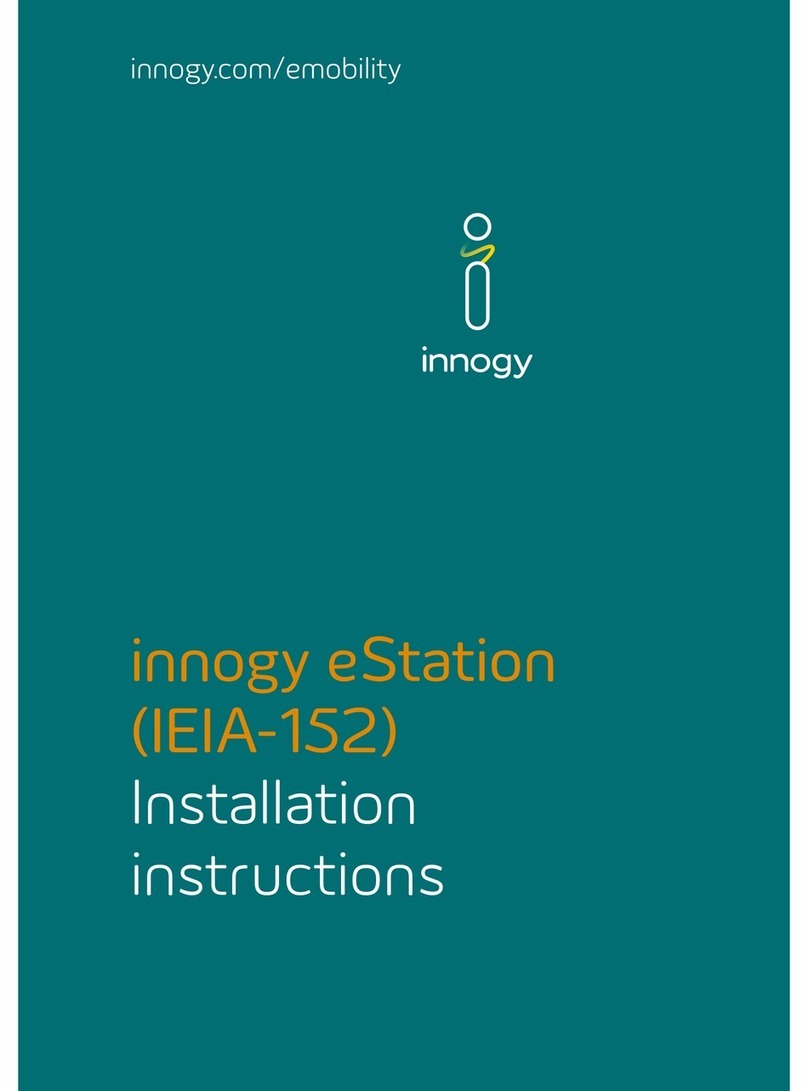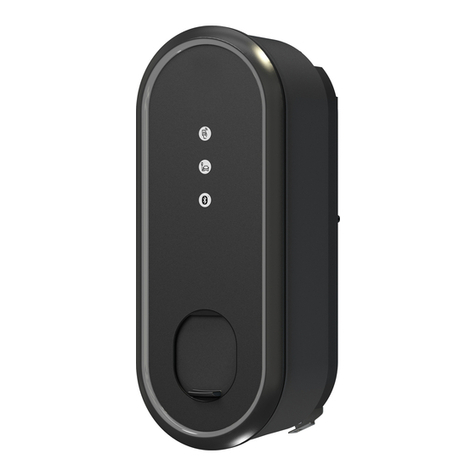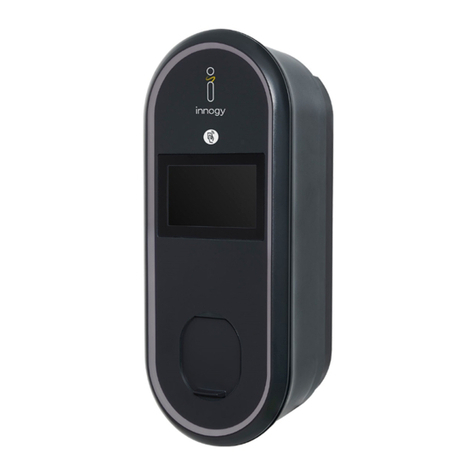Innogy eStation User manual

innogy eStation
(IEIA-152)
Operating
instructions
innogy.com/emobility

innogy eStation (IEIA-152)

Operating instructions
Contents
Refuelling is now charging
Basic safety instructions
Scope of delivery
Technical data
Operation for charging an electric vehicle
Inspection/maintenance
Error messages
20.03.2018 • Version 1.0

Refuelling is now charging
Dear Customer,
innogy SE (hereinafter innogy) provides you with a modern and,
simultaneously, future-proof solution for the rapid charging of
electric vehicles.
We are delighted that you have chosen the innogy eStation and
hope you will be happy as you join us on our common journey:
designing the refuelling of the future!
Your eMobility team
innogy SE
innogy eStation (IEIA-152)
Very important information
Instructions which particularly relate to safety
!
i

Basic safety instructions
This manual contains information on the correct operation of the
innogy eStation. The charging station should be operated and han-
dled according to these operating instructions. The installation in-
structions contain detailed information on installation of the prod-
uct. Failure to comply with these can compromise its function and
safety.
Warranty
The following instructions must be heeded for a
warranty in terms of function and safety:
innogy bears no liability for damage resulting
from non-observance of the instructions.
Warranty and liability conditions of the terms of
sale and delivery or any innogy cooperation
agreements are not extended by the following
instructions.
The product may only be operated after notice
is taken of the corresponding operating instruc-
tions.
The product may only be operated by qualified
skilled personnel who are familiar with the legal
requirements.
The product may only be used for its intended
purpose.
Repair work may only be undertaken by skilled
personnel or appropriately instructed persons.
Additional training is mandatory.
The product may not be converted or modified.
The manufacturer will not bear any liability for
unilateral modifications to the product.
Only suitable accessories may be used with the
product.
Only spare parts listed by innogy in the spare
parts catalogue and, consequently, approved
may be used for repairs.
We reserve the right to make technical changes
in the context of further development. In add-
ition to the instructions in this manual, generally
applicable safety and accident regulations must
be observed!
Usage
These operating instructions relate to the innogy
eStation IEIA-152 and are valid for use of the
innogy eStation within Germany.
Intended use
The device is intended for professional use out-
doors. Instructions for charging are applied to
the innogy eStation above the charging plug.
The operator pledges to maintain this manual in
a permanently legible condition. Knowledge of
these operating instructions is obligatory for
operation of the charging station.
The device is designed exclusively for charging
electric vehicles with a type 2 plug pursuant to
IEC 62196-2 and charging current control via
the pilot signal pursuant to IEC 61851-1. Use for
supplying other devices is not permitted.
Operating instructions
i
i
!

Scope of delivery
The scope of delivery of the
innogy eStation and accessories
is described below.
Components included
in scope of delivery:
• innogy eStation: Charging station for
charging electric vehicles according to
the following technical data
• Two keys
• Operating instructions
• Installation instructions
Further required accessories should
be ordered separately:
• Foundation: A charging station founda-
tion or, alternatively, a mounting frame
is required to ensure the proper stabil-
ity of the innogy eStation.
• Ram protection: In addition, ram
protection is required to protect the
domestic connection against external
influences.
innogy eStation (IEIA-152)
General safety instructions
The innogy charging station is EMC tested and
meets the requirements of EMC Directive
2014/30/EU and the Low Voltage Directive
2014/35/EU. Instructions in manuals for
(mobile/wireless) communication devices
must be observed when using in the vicinity
of (mobile/wireless) communication devices.
Following each charging, the charging cable
connected to the innogy eStation is disconnect-
ed electrically from the power supply network
to ensure voltage-free plugging of the charging
cable at all times.
The electric vehicle is connected with the innogy
eStation via a charging cable for charging. As
the operator of the charging station, you may
have to inform the user in an appropriate man-
ner about the correct use of the charging cable.
innogy bears no liability for any damage occur-
ring due to the improper use of charging cables.
Troubleshooting
Rectifying of faults must be undertaken by an
electrical engineering specialist.

Technical data
Operating instructions
General technical data
Dimensions:
Installation:
Weight:
(H x W x D) 1,460 x 300 x 200 mm
Free-standing on an appropriate concrete base or on a
viable concrete base using a mounting frame
innogy eStation: ~ 42 kg
Ram protection: ~ 18 kg
Foundation: ~ 100 kg
Protection class IP54
Temperature range −25 °C to +40 °C
Grid connection
Power supply:
Required connected load:
400 V 3~ + PE+N
22 kW for simultaneous maximum power at both charging points.
Lower connected loads can be configured.
Charging points and
vehicle connection
No. of charging points:
Output:
Vehicle recognition:
Two charging sockets (type 2)
Max. 11 kW (configurable, 400 V 3~, 16 A) per charging point
Via pilot signal pursuant to IEC 61851-1:2012
Display Multicoloured LED indicates charging, charge status and
error message
Protection technology Integrated for each charging point: Personal protection: RCD type
B (30 mA for DC residual currents and 6 mA for AC residual
currents). Cable protection: circuit breaker.
Authentication/
activation
Via key switch
Communication Pilot signal pursuant to IEC 61851-1:2012
Foil wrapping Weather and graffiti-resistant foil (can be ordered separately).
Individual customer branding possible.
Access authorisation Double-locking system with two 31.5 mm single profile cylinders
!

Operation for charging
an electric vehicle
Prerequisite for charging with the innogy eStation is the
activation of a vehicle on the innogy eStation.
The user of the innogy eStation can avail of the operating
modes described below.
innogy eStation (IEIA-152)
1
If a charging procedure is started during this period, the innogy eStation remains on for
the duration of charging and ultimately deactivates itself automatically. The plug lock
only opens during this if the cable on the vehicle is unplugged.
Operating modes
Ladevorgang beenden
Aus
Ein
1. Off
Ladevorgang beenden
Aus
Ein
2. Permanently on
Ladevorgang beenden
Aus
Ein
3. Operational for the
next 60 seconds
1
2
60 sec.
Ladevorgang beenden
Aus
Ein
4. Deactivation
A
us
Ladevor
g
an
g
beende
n
On On
On
On
Off Off
Off
Off
Charging complete Charging complete
Charging complete
Charging complete
1
2
i

Operating instructions
The operating mode is indicated by
the LED above the key switch.
The following modes are indicated:
“Off”
LED display is off
Charging station operational
LED indicator illuminates white
Vehicle connected
LED indicator illuminates green
Charging active
LED indicator illuminates blue
Charging impossible
LED indicator illuminates red
Charging station faulty
LED indicator flashes red
Risks for humans and the environment
• Stumbling injury due to improper laying of
cables
• There is a danger of electric shock where
defective cables are involved.
• There is a risk from road traffic when installing
and removing the cable in areas where there is
heavy traffic.
Protective measures and rules of conduct
• The charging cable should be routed so
that no risk of stumbling occurs due to the
installation.
• When plugging in the charging cable, ensure
that only charging cables are used that are
visibly and technically sound and intended for
charging.
• Pay particular attention to road traffic on busy
roads.
• Do not attempt to repair defective cables.
Conduct in event of malfunctions
• Have defective charging stations repaired
immediately by appropriate skilled personnel.
• Do not establish an electrical connection if
charging cables or charging points are
defective.
Maintenance or replacement of charging
cables
• Defective cables must be repaired or replaced
by a qualified person.
• Defective cables must not be used any further
on the eStation.
Conduct in case of accidents, first aid
• Switch off the power.
• Provide first aid and secure the danger
zone. Emergency no.: 112
• Make an emergency call and initiate rescue.
Using the charging cable
The following information is provided for the
safe laying of cables for charging of electric
vehicles on the innogy charging station. The
user of the eStation is responsible for the safe
handling of charging cables.
!
!
!
!
!

Inspection/maintenance
innogy eStation (IEIA-152)
Inspection/maintenance
To ensure electrical safety and the function of
the innogy eStation, it should be inspected and
maintained in regular cycles of six months by
qualified skilled personnel to the degree stipu-
lated in DIN VDE 0702 and pursuant to legal
and normative specifications. Deficiencies
occurring due to a failure to observe this will
render all guarantee and warranty claims null
and void.
For inspection/maintenance, innogy recom-
mends the following in addition to legal require-
ments and normative specifications:
• Interior/exterior cleaning
• Checking of the stability of the station
• Functional inspection of mechanical compo-
nents (cable version, plug, door lock)
• Visual inspection of cable connections and
meter
• Checking of functionality of LEDs
• Functional inspection of the residual current
device (RCD) pursuant to DIN VDE 0100-600
• Functional inspection of charging
• Checking of plug lock
Repair
The operator of the innogy eStation is respon-
sible for the correct repair in the case of
damage or malfunction. In the case of repair,
the operator organises correct repair at his or
her own expense, commissions a third party
who has undergone training approved by innogy
or undertakes repair him or herself. innogy can
be commissioned with repair work within
Germany. Repair includes the measures
necessary to restore the charging station
to a safe and functional condition.
In the event of damage being detected during
an inspection/maintenance, damaged parts
should be replaced immediately in as far as
possible. innogy keeps stocks of spare parts
for repair purposes. In the event of replace-
ment of charging infrastructure components,
a repair protocol should be compiled.
Accessibility and response time
In order to report damage, a service hotline
which can be reached 24/7 should be provided
by the operator of the innogy eStation to ob-
serve statutory due diligence. This can be the
innogy service hotline within Germany. Different
time limits apply to problem troubleshooting,
depending on the type of damage which occurs:
• In the event of imminent danger: immediately.
• In the event of failure of significant functions:
at the discretion of the charging station operator.
• In the event of minor damage without func-
tional impairment: at the discretion of the
charging station operator.
Dismantling/removal
Dismantling or removal of an innogy eStation
may only be undertaken by appropriately trained
specialist personnel. The dismantling protocol
must be completed and sent to innogy.
i

Error messages
Operating instructions
LED flashes red 2 x per second:
The charging plug lock is faulty.
• Please check the charging plug (e.g. for dirt).
• Please deactivate and reactivate the charging
station completely once.
LED flashes red continuously:
The supply voltage for charging is inadequate
(or drops too dramatically due to the electrical
load during charging).
• More current is charged from the electric ve-
hicle than can be safely provided via the instal-
lation. Please contact your installation partner.
• Too many consumers are active simultaneously
on your power supply.
LED flashes slowly white 2 x per second:
A charging cable with an invalid current value is
connected.
• Please replace the charging cable with a certi-
fied charging cable suitable for your vehicle.
LED flashes rapidly white 5 x per second:
• The charging cable is defective.
• Please replace the charging cable with a certi-
fied charging cable suitable for your vehicle.
LED flashes rapidly green 5 x per second:
The vehicle signals invalid current values.
• Please disconnect the vehicle from the
charging cable and start the complete
charging procedure from the beginning.
Please contact the manufacturer of your
vehicle if the fault persists.
LED remains permanently white:
Your vehicle is not recognised or the charging
cable is defective.
• Please replace the charging cable with a certi-
fied charging cable suitable for your vehicle.
• Please disconnect the vehicle from the charg-
ing cable and start the complete charging
procedure from the beginning. Please contact
the manufacturer of your vehicle if the fault
persists.
LED flashes slowly green 2 x per second:
The vehicle signals an invalid status.
• Please disconnect the vehicle from the charg-
ing cable and start the complete charging
procedure from the beginning. Please contact
the manufacturer of your vehicle if the fault
persists.

innogy SE
Flamingoweg 1
44139 Dortmund
Germany
emobility@innogy.com
innogy.com/emobility
P-EFFG-65/09.17
Other manuals for eStation
1
This manual suits for next models
1
Table of contents
Other Innogy Batteries Charger manuals





















